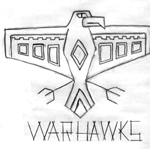So after a successful first season, Stump Matiash thought that he would run a similar league of his own. The league only had five owners and it didn't even make it through a full season before folding (I mean "permanent rain delay"), but it stoked the interest of Brent Campbell, who was invited to become the MicroLeague's first expansion team - the Scranton Sparrows.
Back in the early days of the league, there were no protected lists. It was what is known as a dynasty league. The entire roster was your keeper list. Back in those days, the draft was only ten rounds long, and no supplemental rounds. There was nothing left by that time anyway. Most teams were done drafting by round eight, leading to some joke picks in the final rounds like "Mickey Mantle" or "Mark Zotti". Brent was given the second pick in each round. The thinking was that it would not be fair to deny Maine/San Antonio the first pick that they have so rightfully earned. Brent was then allowed to solo draft for the final rounds to fill out his roster. Naturally the Scranton Sparrows did not fare well that season. With seven teams in the league, the schedule had a "bye series" for one team, meaning that one of the teams would not play for three days. This was also the first year that allowed for 5-man reserve squads, though it was pretty uncommon in those days to stash inelligible players there.
 Having an odd number of teams was just weird, so the Powers That Be decided that the league should expand to ten for the 1993 season. Mark Hazen was the first owner recruited by Steve Zajac. It would mark the only time that an expansion team would make a trade in a year before their inaugural season. The Outlaws traded Rickey Henderson to Hazen's Cheyenne Warhawks for a draft pick. After the other two owners were recruited, the three expansion teams were allowed to make five waiver claims each during the season. With a roster of five players, at least the new expansion teams would not be so far behind going into the new 1993 season.
Having an odd number of teams was just weird, so the Powers That Be decided that the league should expand to ten for the 1993 season. Mark Hazen was the first owner recruited by Steve Zajac. It would mark the only time that an expansion team would make a trade in a year before their inaugural season. The Outlaws traded Rickey Henderson to Hazen's Cheyenne Warhawks for a draft pick. After the other two owners were recruited, the three expansion teams were allowed to make five waiver claims each during the season. With a roster of five players, at least the new expansion teams would not be so far behind going into the new 1993 season.The three expansion teams would be cycled into the second, third and fourth slots in the draft order and rotate each round. The player qualifications were relaxed a little to allow a larger pool of players to be available. Commissioner Yaro Zajac wanted the league to be a little more realistic and since MicroLeague would randomly injure players in the game, he thought that injuries should factor into the game. The problem was that the MicroLeague games had no continuity. The game had no knowledge of what happened in previous games. There was no fatigue, no pitch counts, and no long-term injuries. The game never replaced players in the game unless they were injured or ejected. Even though the games were quick played - note that the quick play was not instantaneous, but more of a fast forward - you could tell when a player was ejected by the music that played when it happened. During the quick play, the game would pause to play the music, then continue quick play. So the commish came up with a scheme to determine if the injury was long-term by a roll of the dice. He set up a chart for a 10-sided die that he found in an old Dungeons and Dragons kit. Three of the numbers indicated a 15-game injury and one number indicated a 30-game injury. The rest were single game injuries. The first player to fall prey to the luck of the dice was Waikiki's Rob Deer. Deer would also become infamous for his record number of strikeouts that season.
1993 was the birth of the MicroLeague Newsletter - a weekly publication featuring stats, rosters, transactions and goings on in the league. It was distributed to its members to that they could better follow the league, since there was no league web site yet. Previously, the owners would have visited the Zajac household or phone in for their results. The Newsletter unfortunately only lasted about seven or eight issues - which are forever enshrined at the DMBL Hall of Fame.
The 1994 season went on pretty much the same. One of the few seasons without any new owners. Of course you may remember that 1994 was the season of the infamous strike in Major League Baseball. The strike left a bad taste in the mouth for many baseball fans and that was also the case with the MicroLeague owners. The league was abandoned and apparently left for dead for the 1995 season.
Next week, we'll take a look at the post-strike MicroLeague and start getting into some DMB...

No comments :
Post a Comment